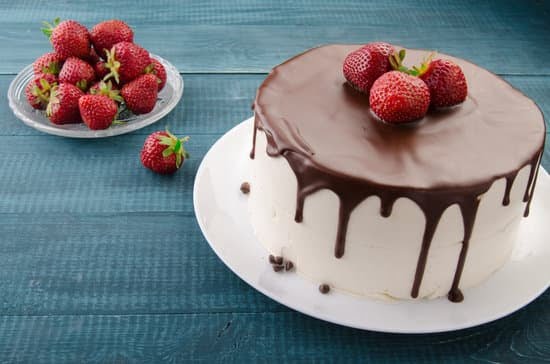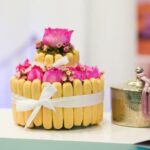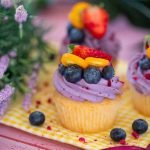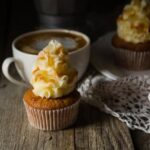Butter cake decoration has become a captivating art form that adds a touch of elegance and charm to any celebration. From birthdays to weddings, beautifully adorned butter cakes have gained immense popularity and significance in recent years.
This article will delve into the world of butter cake decoration, providing a comprehensive guide filled with tips, techniques, and creative ideas to help readers create stunning masterpieces. So whether you’re a beginner or an experienced baker looking to enhance your skills, get ready to explore the endless possibilities of butter cake decoration.
Decorating a butter cake involves more than just spreading some icing on top. It requires precision, attention to detail, and a solid understanding of fundamental techniques. In the next section, we will break down the basics of butter cake decoration through a step-by-step guide. You’ll learn how to choose the right recipe for your base, prepare the perfect icing consistency, and execute various decorating techniques with ease.
To achieve professional-looking butter cake decorations, it’s essential to have the right tools and materials at hand. In section three, we will introduce you to the must-have items for successful decoration. Quality pastry bags, tips, spatulas, and sculpting tools can make all the difference in achieving intricate designs and smooth finishes. We’ll even provide recommendations on specific brands and products that are ideal for beginner decorators.
Join us on this journey as we unlock the secrets of butter cake decoration and inspire your creativity like never before. Whether you’re preparing for an upcoming special occasion or simply looking for a new hobby filled with joy and satisfaction, embracing the art of butter cake decoration is sure to bring delight to both bakers and dessert enthusiasts alike.
So let’s dive in and discover how simple ingredients can be transformed into edible works of art that captivate hearts and taste buds alike.
The Basics of Butter Cake Decoration
Butter cake decoration is a delightful art that allows individuals to showcase their creativity and bring joy to any occasion. Whether it’s a birthday party, wedding, or anniversary celebration, beautifully adorned butter cakes have become an integral part of these special events. In this section, we will explore the basics of butter cake decoration through a step-by-step guide that will help beginners get started on their decorating journey.
Choosing the Right Butter Cake Recipe
One of the most crucial aspects of successful butter cake decoration is choosing the right recipe. A sturdy and moist butter cake will serve as a solid foundation for your decorations. It’s important to find a recipe that yields a tender crumb while still being firm enough to support the weight of the decorations.
Some popular options include vanilla butter cake, chocolate butter cake, and citrus-flavored butter cakes. It’s also essential to pay attention to baking times and temperatures to avoid over or undercooking the cake.
Preparing the Cake and Icing
Once you have selected your desired butter cake recipe, it’s time to prepare the cake for decorating. Start by cooling the cake completely before attempting any decoration techniques. If necessary, level off the top of each layer using a serrated knife or leveling tool to ensure an even surface for your decorations.
Next comes the icing. Buttercream is a popular choice for many decorators due to its versatility and delicious taste. To make buttercream icing, beat softened unsalted butter until creamy, then gradually mix in powdered sugar until well combined. Add flavorings such as vanilla extract or cocoa powder according to your desired taste.
Decorating Techniques
There are several key techniques used in butter cake decoration that every beginner should know:
- Crumb coating: Apply a thin layer of icing called crumb coat on your cooled cake layers before adding additional layers of frosting or decorations. This helps to seal in any loose crumbs and provide a smooth surface for further decoration.
- Piping: Piping is the art of applying icing through a pastry bag fitted with different tips to create various shapes and designs. Decorators can use different tips to achieve patterns like rosettes, borders, stars, or leaves. Practice piping on parchment paper before moving on to your cake.
- Fondant accents: Fondant is commonly used to create decorative elements such as figures, flowers, and intricate designs. Roll out fondant into thin sheets and cut desired shapes using cookie cutters or specialized fondant tools. Attach the fondant accents onto the cake using a small amount of buttercream or edible adhesive.
By following these basic steps and techniques, beginners can embark on their butter cake decoration journey with confidence and creativity. With practice, patience, and a willingness to experiment, anyone can turn a simple butter cake into a stunning masterpiece that will impress both sight and taste buds alike.
Essential Butter Cake Decorating Tools and Materials
In order to create stunning butter cake decorations, it is essential to have the right tools and materials at your disposal. Whether you are a novice decorator or an experienced baker, having the proper equipment can make a significant difference in the outcome of your cake designs. Below, we will explore some of the key tools and materials that are necessary for successful butter cake decoration.
Pastry Bags and Tips
One essential tool for butter cake decoration is a quality pastry bag. Pastry bags come in various sizes and materials, such as disposable plastic or reusable fabric. It is important to choose a sturdy and durable pastry bag that fits comfortably in your hand. Additionally, investing in different sizes of tips will allow you to create various designs and textures on your cakes.
Spatulas
Spatulas are another crucial tool used in butter cake decoration. These flat, flexible utensils are perfect for spreading icing evenly on the surface of your cake. Offset spatulas are particularly useful for creating smooth finishes on layered cakes or adding decorative touches.
Sculpting Tools
For more intricate designs, sculpting tools can be invaluable. These tools allow you to carve and shape decorations out of fondant or other edible mediums. From modeling sculpting tools to embossing wheels, there is a wide range of options available to help you bring your creative visions to life.
| Tool/Material | Recommended Brands/Products |
|---|---|
| Pastry Bag | Wilton Disposable Decorating Bags |
| Tips | Ateco Decorating Tubes Set |
| Offset Spatula | OXO Good Grips Offset Spatula |
| Sculpting Tools | PME Sugarcraft Modeling Tools Set |
Remember, choosing the right tools and materials is just as important as mastering the techniques themselves. With the proper equipment, you can elevate your butter cake decoration skills and unleash your creativity in exciting ways.
Creative Butter Cake Decoration Ideas for Every Occasion
When it comes to butter cake decoration, the possibilities are truly endless. From birthdays to weddings and everything in between, beautifully adorned butter cakes are a must-have centerpiece for any event. In this section, we will explore some creative ideas to inspire your decorating journey and help you create stunning designs for every occasion.
Floral Designs
One of the most timeless and elegant options for butter cake decoration is incorporating floral designs. Whether you opt for delicately piped buttercream flowers or intricately molded fondant blossoms, floral decorations add a touch of sophistication to any cake. Roses, peonies, and daisies are popular choices, but don’t be afraid to experiment with other flowers that suit the theme or color scheme of your event.
Character Cakes
For birthday parties or events centered around a specific theme or character, creating a cake that resembles beloved characters can bring joy and excitement to both children and adults alike. Consider sculpting fondant figures or using edible images to replicate characters from movies, cartoons, or books. These cakes not only serve as delicious treats but also as unique works of art that will be cherished by all.
Abstract Patterns
If you’re looking to make a bold statement with your butter cake decoration, abstract patterns can offer a modern and artistic touch. Think geometric shapes, watercolor-inspired designs, or bold brushstrokes created with vibrant icings or edible paint. Let your creativity run wild as you experiment with various techniques like stenciling or marbling to achieve striking visuals on your cake.
Remember that these are just a few suggestions among countless possibilities for decorating your butter cakes. The key is to let your imagination guide you and tailor the design to suit the occasion and personal preferences. With practice and experimentation, you’ll soon discover your own signature style that will make your creations truly unique and memorable.
So, go ahead and unleash your creativity with butter cake decoration. The joy of seeing your edible masterpiece come to life and the delight it brings to others will make all the effort worthwhile. Whether you choose floral designs, character cakes, abstract patterns, or any other ideas that speak to you, remember to have fun throughout the process and let your passion for creating beautiful cakes shine through.
Expert Tips and Techniques for Achieving Professional-Looking Butter Cake Decorations
To achieve professional-looking butter cake decorations, it is essential to learn from the experts in the field. These tips and techniques shared by professional cake decorators will help you take your cake decorating skills to the next level:
- Icing Consistency: One of the key factors in creating polished cake designs is achieving the right consistency of icing. Professionals recommend using stiff consistency icing for detailed piping work and a medium consistency for covering the cake smoothly. To make your icing more manageable, keep it at room temperature.
- Smoothing Techniques: Smooth, flawless icing on a butter cake can elevate its overall appearance. A popular technique used by professionals is called the “Viva Paper Towel Method.” After applying a crumb coat or base layer of icing, gently press a Viva paper towel against the surface and smooth it using your hand or a fondant smoother. This method helps achieve a perfectly smooth finish.
- Intricate Details: Adding intricate details to your butter cake decorations requires patience and precision. Professionals suggest using small decorating tips with fine points for intricate work. It is also helpful to have toothpicks, modeling tools, or small paintbrushes on hand for making delicate lines, textures, or patterns.
- Vibrant Coloring: Creating vibrant colors that pop on your butter cakes can be achieved by using gel-based food coloring instead of liquid food coloring. Gel-based colors are concentrated and provide more intense shades without altering the consistency of the icing.
- Piping Techniques: Piping is an art form that can truly enhance a butter cake’s decoration. Professionals advise practicing different piping techniques like rosettes, loops, drop flowers, and basketweave to add variety to your cake designs. It is also helpful to use a piping nail and parchment paper to perfect your piping skills before transferring the design onto the cake.
- Realistic Textures: To create realistic textures on butter cakes, professionals suggest using various tools like textured mats, impression rolling pins, or molds. These tools can help achieve patterns like quilted effects, wood grain textures, or even delicate flower imprints.
By incorporating these expert tips and techniques into your butter cake decoration endeavors, you can elevate your creations and impress both yourself and others with professional-looking results. Remember to practice these skills regularly and have patience while mastering them. With time and dedication, you will be able to create stunning butter cake decorations that will surely impress any audience.
Buttercream vs. Fondant
When it comes to butter cake decoration, one of the most important decisions you’ll have to make is choosing the perfect icing. Two popular options that often come up in this discussion are buttercream and fondant. Both icings have their unique qualities and applications, so it’s important to understand the benefits and challenges of each before making your decision.
Buttercream icing is a classic choice for butter cake decoration. Made from a mixture of butter, powdered sugar, and flavorings, buttercream has a rich and creamy texture that pairs well with the tender crumb of a butter cake. Its versatility allows for smooth finishes or intricate piping designs, depending on your preference. Buttercream also offers a wide range of flavors and can be easily tinted with food coloring for decorative purposes.
Fondant icing, on the other hand, provides a sleek and polished look to butter cakes. Made from sugar, water, and glucose syrup or gelatin, fondant creates a smooth canvas that allows for flawless decorations. It is known for its pliability which makes it easier to work with when creating intricate details or covering larger cakes. Fondant also offers more possibilities in terms of sculpting three-dimensional decorations such as flowers or figurines.
However, both icings have their challenges as well. Buttercream can be sensitive to temperature changes and may melt or sag if exposed to heat for too long. Cracks or air bubbles may also occur during application if not done properly. On the other hand, fondant can sometimes be time-consuming to make from scratch and can dry out quickly if not stored properly. Achieving a smooth finish without any creases or wrinkles may require some practice as well.
Ultimately, the choice between buttercream and fondant comes down to personal preference and the desired outcome of your cake decoration. If you prefer a traditional look with delicious taste, buttercream might be the way to go. If you’re aiming for a more polished and sleek appearance, fondant can help achieve that. Some decorators even mix the two icings to benefit from the best of both worlds – the creamy taste of buttercream combined with the smooth finish of fondant.
Whichever icing you choose, it’s important to practice your techniques and experiment with different recipes until you find what works best for you. The more you practice, the better you’ll become at achieving professional-looking butter cake decorations. So go ahead and embrace your creativity as you embark on this delightful journey of butter cake decoration.
Troubleshooting Butter Cake Decoration Challenges and Solutions
Butter cake decoration can be a delightful and rewarding experience, but it also comes with its fair share of challenges. In this section, we will address some common issues that beginners may encounter in butter cake decoration and provide troubleshooting solutions to help you overcome them. By understanding these challenges and learning how to solve them, you can ensure that your cake decorations turn out visually appealing and professional-looking.
One common issue faced by beginner decorators is the presence of air bubbles in the icing. These air bubbles can create an uneven surface and detract from the overall appearance of the cake. To prevent this, make sure to properly mix your icing before applying it to the cake.
Use a spatula or a paddle attachment on low speed to gently remove any air bubbles from the mixture. Additionally, tapping the filled piping bag against a flat surface can help release trapped air before decorating.
Another challenge that decorators often face is achieving clean and neat edges on their butter cakes. Messy edges can make even beautifully decorated cakes look amateurish. To avoid this issue, use a sharp knife or bench scraper to trim the top of your cake before applying the icing.
This will create a smooth surface for decorating and help achieve clean edges. Additionally, chilling your cake in the refrigerator for about 30 minutes after applying a crumb coat can help firm up the icing and make it easier to achieve clean edges when applying the final coat.
Consistency of icing is crucial for successful butter cake decoration. Icing that is too stiff or too runny can make it difficult to achieve desired designs and decorations. To achieve proper consistency, start with a thick batch of buttercream icing and gradually add small amounts of liquid (such as milk or water) until you reach the desired consistency.
If your icing becomes too runny, adding more confectioners’ sugar can thicken it up. On the other hand, if your icing is too stiff, add more liquid gradually until it reaches the desired consistency.
By addressing these common challenges and applying the troubleshooting solutions provided, you can overcome obstacles in butter cake decoration and create visually stunning creations. Remember to be patient with yourself and practice regularly to improve your skills. With time and dedication, you will be able to create beautiful butter cake decorations that will impress your friends and family.
Showcasing Your Culinary Masterpiece
Whether you are a professional cake decorator or a passionate home baker, showcasing your beautifully decorated butter cake through stunning photographs is essential to truly capture and share the artistry of your creation. The right photography techniques can elevate your cake decoration skills and make your masterpiece shine even brighter.
In this section, we will provide you with valuable tips for photographing butter cake decorations that will help you capture the intricate details, vibrant colors, and overall aesthetics of your culinary creation.
- Lighting: When it comes to food photography, lighting is everything. Natural light is often the best choice as it helps showcase the true colors and details of your cake. Set up near a large window or outside in diffused natural light for soft illumination. Avoid direct sunlight as it can create harsh shadows. If necessary, use white bounce boards or reflectors to redirect light onto areas that need additional brightness.
- Angles and Composition: Experiment with different angles to find the most flattering perspective for your cake. A straight-on shot highlighting the frontal view can be great for showcasing intricate piping or sculpted details.
However, don’t be afraid to try overhead shots that capture the full spread of your cake or angled shots that emphasize depth and height. Consider using a tripod to ensure steady shots and allow yourself more freedom in trying out various compositions. - Styling and Props: While the focus should remain on your butter cake decoration, adding some complementary props can enhance the overall visual appeal of your photograph. Consider incorporating utensils, ingredients, fresh flowers, or beautiful serving plates that match the theme or color scheme of your cake decoration. Keep in mind not to overcrowd the scene; simplicity often works best.
- Editing: After capturing your photographs, editing them can take them from good to exceptional. Use photo editing software or apps to adjust brightness, contrast, sharpness, and color balance if needed. However, remember not to overdo it – aim for a natural and realistic look that accurately represents the colors and details of your cake.
- Practice and Experiment: The more you practice photographing butter cake decorations, the better you will become at capturing their essence beautifully. Don’t hesitate to experiment with different techniques, angles, and compositions to find your unique style. Take inspiration from other cake decorators and photographers to continually improve your skills.
By following these tips, you can ensure that your photographs truly showcase the artistic beauty of your butter cake decorations. Remember, photography is an art form in itself, so have fun exploring different techniques and styles. With the right lighting, angles, composition, props, and editing skills, you can capture jaw-dropping images that showcase your culinary masterpiece in all its glory.
Conclusion
In conclusion, butter cake decoration is an art form that has grown tremendously in popularity and significance. The beautifully adorned butter cakes have become the centerpiece of celebrations and events, captivating guests with their stunning designs.
Throughout this article, we have explored the basics of butter cake decoration, learned about essential tools and materials, discovered creative decoration ideas for every occasion, gained expert tips for achieving professional-looking designs, discussed the choice between buttercream and fondant icings, tackled common challenges and provided troubleshooting solutions, and even delved into the art of photographing these culinary masterpieces.
As we wrap up our exploration of butter cake decoration, it is important to remember that the key to successful cake decorating lies in embracing your creativity. Allow yourself to think outside the box when it comes to design ideas. Don’t be afraid to experiment with different techniques, colors, and textures. The world of butter cake decoration is rich with endless possibilities waiting to be discovered.
Whether you are a beginner taking your first steps or an experienced decorator looking for new inspirations, I encourage you to embark on this decorating journey with confidence and joy. Remember that practice makes perfect and each decorated cake is an opportunity for growth and improvement. Let your imagination soar as you create edible works of art that bring joy to both yourself and those who are fortunate enough to enjoy your delectable creations.
So go forth, armed with the knowledge from this article, unleash your creativity on a blank canvas of butter cake. Discover the beauty that lies within every swirl of icing, every brushstroke of color, and every intricate detail. Enjoy the process as much as the end result because in butter cake decoration lies not only sweet treats but also a world full of possibility where creativity knows no bounds.
Frequently Asked Questions
How to decorate a cake with butter icing?
Decorating a cake with butter icing requires a few simple steps. First, make sure your cake has cooled completely before starting the decorating process. Prepare your butter icing by creaming together softened butter and powdered sugar until light and fluffy. If desired, add in flavorings such as vanilla extract or cocoa powder for different variations.
Once your icing is ready, spread a thin layer onto the cake using an offset spatula, making sure to cover the entire surface evenly. For more intricate designs, use piping bags fitted with various tips to create borders, flowers, or other decorative elements. Be creative and experiment with different techniques to achieve your desired look. Lastly, you can further adorn your cake with sprinkles, edible pearls, or other decorations to add texture and visual appeal.
How to decorate butter cake without icing?
If you prefer not to use icing on a butter cake but still want to decorate it, there are several alternatives available. First and foremost, you can enhance the appearance of the cake by dusting it lightly with powdered sugar or cocoa powder using a small sieve for an elegant touch. Another option is to create a glaze by combining ingredients like melted chocolate or fruit juice with powdered sugar until smooth and glossy in texture.
This glaze can be poured over the top of the cake, allowing it to drizzle down the sides naturally for an effortless yet visually appealing decoration. Additionally, fresh fruits such as berries or sliced citrus can be arranged on top of the cake to add color and freshness while also creating an attractive presentation.
How far in advance can you decorate a cake with buttercream?
Buttercream is known for its stability and ability to hold up well when prepping cakes in advance. You can typically decorate a cake with buttercream anywhere from one to three days ahead of time without sacrificing taste or quality. To ensure freshness during this time frame, it’s important to store your decorated cake properly.
Keep the cake covered loosely with plastic wrap or place it inside a cake storage container at room temperature away from direct sunlight or heat sources. Avoid refrigerating buttercream-decorated cakes unless necessary, as this can cause the icing to harden and lose its smoothness. Remember, the longer the cake sits, the more time it has for flavors to meld and become even better.

Welcome to our cake decorating blog! My name is Destiny Flores, and I am the proud owner of a cake decorating business named Cake Karma. Our mission is to provide delicious, beautiful cakes for all occasions. We specialize in creating custom cakes that are tailored specifically to each customer’s individual needs and tastes.





